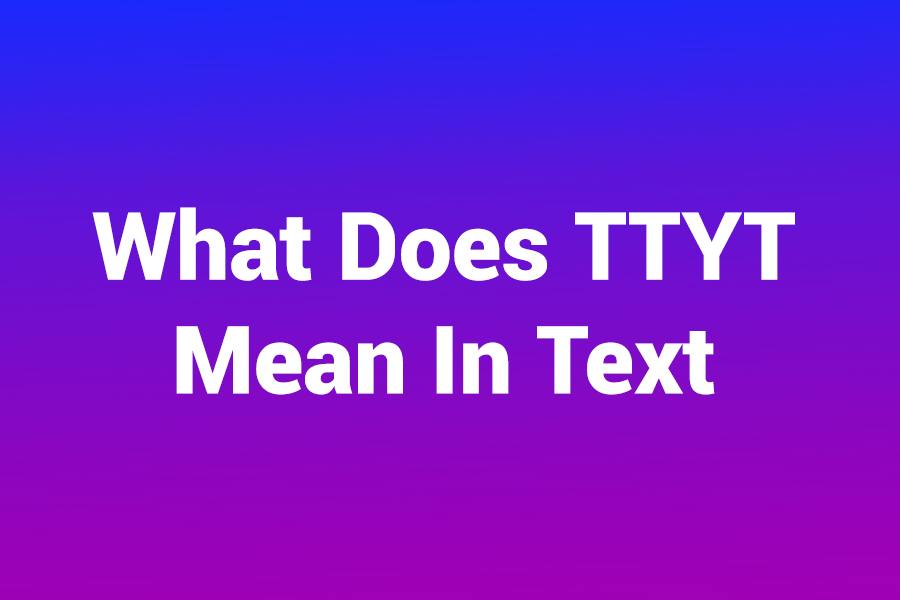In today’s fast-paced digital world, we use text shorthand like “lol,” “brb,” and “ttyl” without thinking twice. But do you truly know what ttyl means? In this article, we’ll explain what ttyl stands for, how people use it, when it’s appropriate, and some better alternatives you might prefer.
You’ll also get usage examples and reply ideas so you use ttyl confidently in your texts and chats — in this article.
What Does TTYL Mean?
TTYL is an initialism that stands for “Talk To You Later.” It’s a casual way to say goodbye or pause a conversation, with the clear implication that you intend to reconnect in the future.
Because ttyl is informal, you’ll mostly see it in text messages, chats, social media direct messages, and informal emails—not in formal settings. The abbreviation helps keep conversations efficient and friendly.
Origin & History
The use of ttyl emerged alongside early online chat and instant messaging culture in the 1980s and 1990s. As people sought faster ways to communicate in chat rooms, bulletin boards, and early messaging platforms, abbreviations like ttyl spread. Over time, it made its way into mobile text messaging and social media.
Part of the reason these abbreviations thrived was due to early SMS character limits (often 160 characters) and the difficulty of typing on numeric keypads. Using fewer letters made texts faster and cheaper to send. Today, while character limits and text costs matter less, the shorthand remains popular thanks to habit and speed.
How Is TTYL Used?
People typically use ttyl in casual, non-urgent conversations when they need to leave the chat but intend to come back later. It often appears at the end of a message or as a sign-off.
Here are a few usage patterns:
- At the end of a message: “Gotta head out now, ttyl.”
- Standalone: “Alright, ttyl.”
- With extra tone: “I’m off to work for 2 hours — ttyl!”
You’ll see ttyl across platforms: texting apps (iMessage, SMS, WhatsApp), social media DMs (Instagram, Facebook), chat apps (Slack, Discord), and sometimes even comments.
When You Should (and Shouldn’t) Use TTYL
Use ttyl when:
- You’re chatting with friends or family.
- The topic is casual or light.
- You’ll likely come back to the conversation later.
- You want a friendly, relaxed ending to the chat.
Avoid ttyl in:
- Formal or professional messages (use “Talk soon,” “Let’s reconnect,” etc.).
- Situations where a precise schedule or plan matters.
- Conversations about serious or sensitive topics—you don’t want to seem dismissive.
- When you don’t intend to reach out again—it can come across as vague or insincere.
Examples of TTYL in Texts
- Friend A: “I need to run to class now.”
Friend B: “No worries. ttyl! :)” - Coworker A: “Meeting’s about to start.”
Coworker B: “Understood. ttyl about the next steps.” - Sibling A: “Heading to bed. ttyl.”
Sibling B: “Goodnight! Talk later.” - Significant Other A: “I’ll be busy for a few hours.”
Partner B: “Alright. ttyl, love.”
How to Reply When Someone Says TTYL
When someone sends ttyl, you can respond according to your relationship and tone:
- Casual: “Cool, ttyl!”
- Friendly: “Okay, talk soon!”
- Warm: “Alright, can’t wait — ttyl.”
- Polite (if in semi-professional setting): “Understood. Talk later.”
The key is matching their tone rather than overthinking it.
Variants and Similar Acronyms
There are several related abbreviations with overlapping meaning. Here are a few:
- TTYS — Talk To You Soon
- BRB — Be Right Back
- GTG — Got To Go
- L8R — Later
- TTYT — Talk To You Tomorrow
- BFN — Bye For Now
- TTFN — Ta-Ta For Now
These serve different shades of meaning—some imply a brief pause, others imply reconnection soon or at a later time.
Why TTYL Keeps Being Popular
Even now, with full keyboards, autocorrect, and voice typing, ttyl endures. Why?
- Habit & familiarity — It’s ingrained in texting lexicon.
- Tone & casualness — ttyl feels friendly and low-pressure.
- Efficiency — It’s just four letters to convey a full phrase.
- Universality — Most English speakers understand it instantly.
Recent research on texting language suggests that while abbreviations may sometimes reduce perceived sincerity, they remain deeply embedded in digital culture. Their simplicity and speed often win out in typical casual chats.
Tips for Smarter Usage
- Reserve ttyl for casual situations.
- Add an emoji or name to soften the tone: “Alright, ttyl 😊” or “Bye — ttyl, Sam.”
- In more formal settings, replace it with: “Talk soon,” “Let’s reconnect later,” or “I’ll reach out again.”
- Don’t combine ttyl with abrupt exits—if you use it, follow through by returning later.
- Match the tone of the conversation; don’t force it if the other person is serious.
Is TTYL Always a Promise?
Using ttyl doesn’t always guarantee a message later, though in most cases it implies intention. Sometimes people use it as a polite exit without strong commitment to reconnect immediately. Take cues from the rest of the conversation—if the chat was meaningful, chances are they really mean it.
Why Context Matters
Consider who you’re texting and how well you know them. If a colleague texts ttyl, it’s safer to assume a professional break, not an invitation for casual follow-up. Among friends, it’s just a friendly sign-off. When texting someone new, using ttyl too soon might seem overly casual or ambiguous.
Final Thoughts
TTYL means Talk To You Later and acts as a casual way to pause a conversation while leaving the door open for future chat. It’s most at home in friendly, informal messaging and less so in formal or serious communication.
Use it wisely, pick your tone, match the context, and you’ll make digital conversations smoother and more natural.

